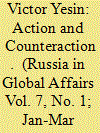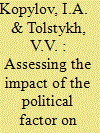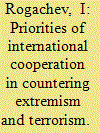| Srl | Item |
| 1 |
ID:
087874


|
|
|
|
|
| Publication |
2009.
|
| Summary/Abstract |
Washington's plan to deploy a European segment of its missile defence system is a most sensitive issue and a major pet peeve of Russia - U.S. relations. Many observers agree that the ability of the sides to find a compromise solution to this problem would be indicative of the prospects for bilateral ties in the years to come.
PASSIONS OVER THE THIRD POSITION AREA
The planned third position area of a U.S. global missile defence system would include silos with interceptor missiles in Poland (the Ustka military range near the town of Slupsk in Pomeranian Voivodeship) and a missile defence radar in the Czech Republic (the Brdy military area near Jince, 60 km south-west of Prague). The first and second position areas of the ground-based echelon of the U.S. strategic missile defence system are deployed on the territory of the United States - in Fort Greely, Alaska and at Vandenberg Air Force Base, California, respectively.
The decision made by Washington in late 2005 to deploy a third position area near Russia's western border was taken by Moscow as a threat to its national security. (For more on this subject, see "Missile Defence Challenges" by Pavel Zolotarev in Russia in Global Affairs, N 3, July-September 2008.) To allay Moscow's fears, the George W. Bush administration made several attempts between 2006 and 2008 to convince the Russian leadership that the third position area was not directed against Russia.
|
|
|
|
|
|
|
|
|
|
|
|
|
|
|
|
| 2 |
ID:
191485


|
|
|
|
|
| Summary/Abstract |
This paper offers a definition of the scientific term "political factor." It offers a classification based on numerous criteria and grounds, as well as a methodology of assessing its influence on national defense management in the Russian Federation in light of the destructive policies of the US and its allies.
|
|
|
|
|
|
|
|
|
|
|
|
|
|
|
|
| 3 |
ID:
161066


|
|
|
|
|
| Summary/Abstract |
ON APRIL 3, 2018, the Russian Ministry of Foreign Affairs, together with the Russian Ministry of Internal Affairs, held an international research to practice conference, "Priorities of International Cooperation in Countering Extremism and Terrorism," at the V.Ya. Kikot Moscow University of the MIA.
|
|
|
|
|
|
|
|
|
|
|
|
|
|
|
|
| 4 |
ID:
177783


|
|
|
|
|
| Summary/Abstract |
The international community often seeks to promote political reforms in recalcitrant states. Recently, some scholars have argued that, rather than helping, international law and advocacy create new problems because they have negative spillovers that increase rights violations. We review three mechanisms for such spillovers: backlash, trade-offs, and counteraction and concentrate on the last of these. Some researchers assert that governments sometimes “counteract” international human rights pressures by strategically substituting violations in adjacent areas that are either not targeted or are harder to monitor. However, most such research shows only that both outcomes correlate with an intervention—the targeted positively and the spillover negatively. The burden of proof, however, should be as rigorous as those for studies of first-order policy consequences. We show that these correlations by themselves are insufficient to demonstrate counteraction outside of the narrow case where the intervention is assumed to have no direct effect on the spillover, a situation akin to having a valid instrumental variable design. We revisit two prominent findings and show that the evidence for the counteraction claim is weak in both cases. The article contributes methodologically to the study of negative spillovers in general by proposing mediation and sensitivity analysis within an instrumental variables framework for assessing such arguments. It revisits important prior findings that claim negative consequences to human rights law and/or advocacy, and raises critical normative questions regarding how we empirically evaluate hypotheses about causal mechanisms.
|
|
|
|
|
|
|
|
|
|
|
|
|
|
|
|